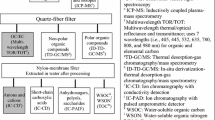Abstract
The performance of two aerosol testing systems, at two different laboratories (University of Nebraska Medical Center—UNMC and 3M Company), was compared to evaluate which calibration procedures minimized variability in filter testing of nanoparticles. Both charged electret and uncharged flat-web fibrous filters were used with Scanning Mobility Particle Sizers to give upstream and downstream size distributions and calculate filter penetration. Challenge aerosols were polydisperse nanoparticles of sodium chloride (NaCl) ranging from approximately 10–300 nm and monodisperse polystyrene latex (PSL) spheres of preselected sizes, including 40, 60, 100, and 200 nm. The implementation of optimized procedures resulted in comparable filtration performance at the two testing sites with challenges of NaCl particles and PSL spheres. The penetration results for the uncharged filter were nearly identical for both challenges, while lower penetration through the charged filter was observed with NaCl aerosol, probably due to differences in NaCl and PSL dielectric constants. Results showed that reproducible, comparable nanoparticle filtration data could be achieved between two separate laboratories when sources of error and proper calibration procedures were addressed.








Similar content being viewed by others
References
Balazy A, Toivola M, Adhikari A, Sivasubramani S, Reponen T, Grinshpun S (2006) Do N95 respirators provide 95% protection level against airborne viruses, and how adequate are surgical masks? Am J Infect Control 34(2):51–57
Brown RC (1993) Air filtration. An integrated approach to the theory and applications of fibrous filters, chapter 6: particle capture by electric forces. Pergamon Press, Oxford
Emi H, Kanaoka C, Otani Y, Ishiguro T (1987) Collection mechanisms of an electret filter. Part Sci Technol 5:161–171
Eninger RM, Honda T, Adhikari A, Heinonen-Tanski H, Reponen T, Grinshpun SA (2008) Filter performance of N99 and N95 facepiece respirators against viruses and ultrafine particles. Ann Occup Hyg 52(5):385–396
Hinds WC (1999) Aerosol technology: properties, behavior, and measurement of airborne particles, chapter 9, 2nd edn. John Wiley and Sons, New York
Hughes MP (2002) Dielectrophoretic behavior of latex nanospheres: low-frequency dispersion. J Colloid Interface Sci 250:291–294
Japuntich DA, Franklin LM, Pui DY, Kuehn TH, Kim SC, Viner AS (2007) A comparison of two nano-sized particle air filtration tests in the diameter range of 10 to 400 nanometers. J Nanopart Res 9(1):93–107
Kanaoka C, Emi H, Otani Y, Iiyama T (1987) Effect of charging state of particles on electret filtration. Aerosol Sci Technol 7(1):1–13
Kim SC, Harrington MS, Pui DYH (2007) Experimental study of nanoparticles penetration through commercial filter media. J Nanopart Res 9(1):17–125
Kreyling WG, Semmler-Behnke M, Möller W (2006) Ultrafine particle–lung interactions: does size matter? J Aerosol Med 19(1):74–83
Lee KW, Liu BYH (1980) On the minimum efficiency and the most penetrating particle size for fibrous filters. J Air Pollut Control Assoc 30:377–381
NIOSH (1997) 42 CFR 84 respiratory protective devices; final rules and notice. Federal register 60:110. US Centers for Disease Control and Prevention, National Institute for Occupational Safety and Health
Otani Y, Emi H, Mori J (1993) Initial collection efficiency of electret filter and its durability for solid and liquid particles. KONA Powder Part 11:207–214
Rengasamy S, King WP, Eimer BC, Shaffer RE (2008) Filtration performance of NIOSH-approved N95 and P100 filtering facepiece respirators against 4 to 30 nanometer-size nanoparticles. J Occup Environ Hyg 5(9):556–564
Rengasamy S, Eimer BC, Shaffer RE (2009) Comparison of nanoparticle filtration performance of NIOSH-approved and CE-marked particulate filtering facepiece respirators. Ann Occup Hyg 53(2):117–128
Shaffer RE, Rengasamy S (2009) Respiratory protection against airborne nanoparticles: a review. Special issue: environmental and human exposure of nanomaterials. J Nanopart Res 11(7):1661–1672
Stevens GA, Moyer ES (1989) “Worst case” aerosol testing parameters: I. Sodium chloride and dioctyl phthalate aerosol filter efficiency as a function of particle size and flow rate. Am Ind Hyg Assoc J 50(5):257–264
Yang S, Lee W-MG, Huang H-L, Huang Yi-C, Luo C-H, Wu C-C, Yu K-P (2007) Aerosol penetration properties of an electret filter with submicron aerosols with various operating factors. J Environ Sci Health 42(1):51–57
Acknowledgment
This material is based upon work supported in part by the Air Force Research Laboratory, Tyndall Air Force Base, Florida under Contract No. FA8650-07-C-5911.
Author information
Authors and Affiliations
Corresponding author
Rights and permissions
About this article
Cite this article
Lore, M.B., Sambol, A.R., Japuntich, D.A. et al. Inter-laboratory performance between two nanoparticle air filtration systems using scanning mobility particle analyzers. J Nanopart Res 13, 1581–1591 (2011). https://doi.org/10.1007/s11051-010-9909-2
Received:
Accepted:
Published:
Issue Date:
DOI: https://doi.org/10.1007/s11051-010-9909-2




